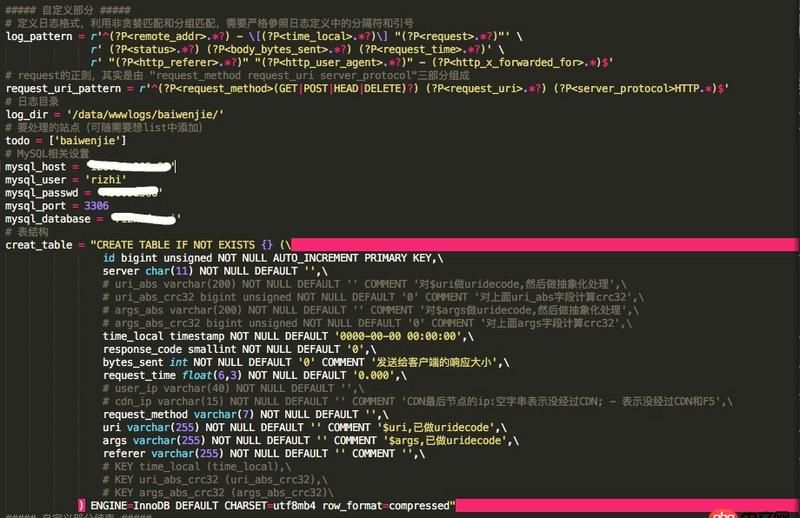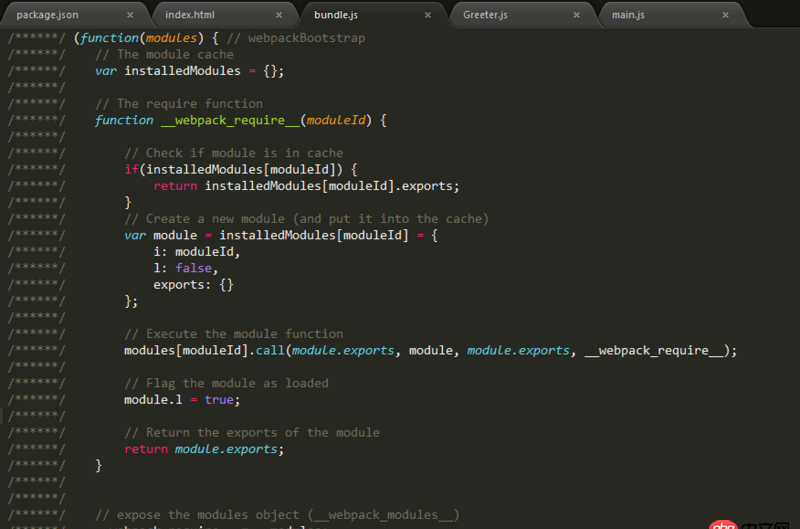python運(yùn)行后沒有任何反饋要怎么排查
問題描述
python3.5.2運(yùn)行以下代碼
#!/bin/env python3# coding:utf-8'''ljk 20161116(update 20170217)This script should be put in crontab in every web server.Execute every n minutes.Collect nginx access log, process it and insert the result into mysql.'''import osimport reimport subprocessimport timeimport warningsimport pymysqlfrom sys import argv, exitfrom socket import gethostnamefrom urllib.parse import unquotefrom zlib import crc32from multiprocessing import Pool##### 自定義部分 ###### 定義日志格式,利用非貪婪匹配和分組匹配,需要嚴(yán)格參照日志定義中的分隔符和引號log_pattern = r’^(?P<remote_addr>.*?) - [(?P<time_local>.*?)] '(?P<request>.*?)'’ r’ (?P<status>.*?) (?P<body_bytes_sent>.*?) (?P<request_time>.*?)’ r’ '(?P<http_referer>.*?)' '(?P<http_user_agent>.*?)' - (?P<http_x_forwarded_for>.*)$’# request的正則,其實(shí)是由 'request_method request_uri server_protocol'三部分組成request_uri_pattern = r’^(?P<request_method>(GET|POST|HEAD|DELETE)?) (?P<request_uri>.*?) (?P<server_protocol>HTTP.*)$’# 日志目錄log_dir = ’/data/wwwlogs/’# 要處理的站點(diǎn)(可隨需要想list中添加)todo = [’www’]# MySQL相關(guān)設(shè)置mysql_host = ’處理過’mysql_user = ’處理過’mysql_passwd = ’處理過’mysql_port = 3306mysql_database = ’處理過’# 表結(jié)構(gòu)creat_table = 'CREATE TABLE IF NOT EXISTS {} (id bigint unsigned NOT NULL AUTO_INCREMENT PRIMARY KEY,server char(11) NOT NULL DEFAULT ’’,uri_abs varchar(200) NOT NULL DEFAULT ’’ COMMENT ’對$uri做uridecode,然后做抽象化處理’,uri_abs_crc32 bigint unsigned NOT NULL DEFAULT ’0’ COMMENT ’對上面uri_abs字段計(jì)算crc32’,args_abs varchar(200) NOT NULL DEFAULT ’’ COMMENT ’對$args做uridecode,然后做抽象化處理’,args_abs_crc32 bigint unsigned NOT NULL DEFAULT ’0’ COMMENT ’對上面args字段計(jì)算crc32’,time_local timestamp NOT NULL DEFAULT ’0000-00-00 00:00:00’,response_code smallint NOT NULL DEFAULT ’0’,bytes_sent int NOT NULL DEFAULT ’0’ COMMENT ’發(fā)送給客戶端的響應(yīng)大小’,request_time float(6,3) NOT NULL DEFAULT ’0.000’,user_ip varchar(40) NOT NULL DEFAULT ’’,cdn_ip varchar(15) NOT NULL DEFAULT ’’ COMMENT ’CDN最后節(jié)點(diǎn)的ip:空字串表示沒經(jīng)過CDN; - 表示沒經(jīng)過CDN和F5’,request_method varchar(7) NOT NULL DEFAULT ’’,uri varchar(255) NOT NULL DEFAULT ’’ COMMENT ’$uri,已做uridecode’,args varchar(255) NOT NULL DEFAULT ’’ COMMENT ’$args,已做uridecode’,referer varchar(255) NOT NULL DEFAULT ’’ COMMENT ’’,KEY time_local (time_local),KEY uri_abs_crc32 (uri_abs_crc32),KEY args_abs_crc32 (args_abs_crc32) ) ENGINE=InnoDB DEFAULT CHARSET=utf8mb4 row_format=compressed'##### 自定義部分結(jié)束 ###### 主機(jī)名global serverserver = gethostname()# 今天零點(diǎn)global today_starttoday_start = time.strftime(’%Y-%m-%d’, time.localtime()) + ’ 00:00:00’# 將pymysql對于操作中的警告信息轉(zhuǎn)為可捕捉的異常warnings.filterwarnings(’error’, category=pymysql.err.Warning)def my_connect(): '''鏈接數(shù)據(jù)庫''' global connection, con_cur try:connection = pymysql.connect(host=mysql_host, user=mysql_user, password=mysql_passwd, charset=’utf8mb4’, port=mysql_port, autocommit=True, database=mysql_database) except pymysql.err.MySQLError as err:print(’Error: ’ + str(err))exit(20) con_cur = connection.cursor()def create_table(t_name): '''創(chuàng)建各站點(diǎn)對應(yīng)的表''' my_connect() try:con_cur.execute(creat_table.format(t_name)) except pymysql.err.Warning:passdef process_line(line_str): ''' 處理每一行記錄 line_str: 該行數(shù)據(jù)的字符串形式 ''' processed = log_pattern_obj.search(line_str) if not processed:’’’如果正則根本就無法匹配該行記錄時(shí)’’’print('Can’t process this line: {}'.format(line_str))return server, ’’, 0, ’’, 0, ’’, ’’, ’’, ’’, ’’, ’’ else:# remote_addr (客戶若不經(jīng)過代理,則可認(rèn)為用戶的真實(shí)ip)remote_addr = processed.group(’remote_addr’)# time_localtime_local = processed.group(’time_local’)# 轉(zhuǎn)換時(shí)間為mysql date類型ori_time = time.strptime(time_local.split()[0], ’%d/%b/%Y:%H:%M:%S’)new_time = time.strftime(’%Y-%m-%d %H:%M:%S’, ori_time)# 處理uri和argsrequest = processed.group(’request’)request_further = request_uri_pattern_obj.search(request)if request_further: request_method = request_further.group(’request_method’) request_uri = request_further.group(’request_uri’) uri_args = request_uri.split(’?’, 1) # 對uri和args進(jìn)行urldecode uri = unquote(uri_args[0]) args = ’’ if len(uri_args) == 1 else unquote(uri_args[1]) # 對uri和args進(jìn)行抽象化 uri_abs = text_abstract(uri, ’uri’) args_abs = text_abstract(args, ’args’) # 對庫里的uri_abs和args_abs字段進(jìn)行crc32校驗(yàn) uri_abs_crc32 = crc32(uri_abs.encode()) args_abs_crc32 = 0 if args_abs == ’’ else crc32(args_abs.encode())else: print(’$request abnormal: {}’.format(line_str)) request_method = ’’ uri = request uri_abs = ’’ uri_abs_crc32 = 0 args = ’’ args_abs = ’’ args_abs_crc32 = 0# 狀態(tài)碼,字節(jié)數(shù),響應(yīng)時(shí)間response_code = processed.group(’status’)bytes_sent = processed.group(’body_bytes_sent’)request_time = processed.group(’request_time’)# user_ip,cdn最后節(jié)點(diǎn)ip,以及是否經(jīng)過F5http_x_forwarded_for = processed.group(’http_x_forwarded_for’)ips = http_x_forwarded_for.split()# user_ip:用戶真實(shí)ip# cdn_ip: CDN最后節(jié)點(diǎn)的ip,’’表示沒經(jīng)過CDN;’-’表示沒經(jīng)過CDN和F5if http_x_forwarded_for == ’-’: ’’’沒經(jīng)過CDN和F5’’’ user_ip = remote_addr cdn_ip = ’-’elif ips[0] == remote_addr: ’’’沒經(jīng)過CDN,經(jīng)過F5’’’ user_ip = remote_addr cdn_ip = ’’else: ’’’經(jīng)過CDN和F5’’’ user_ip = ips[0].rstrip(’,’) cdn_ip = ips[-1]return (server, uri_abs, uri_abs_crc32, args_abs, args_abs_crc32, new_time, response_code, bytes_sent,request_time, user_ip, cdn_ip, request_method, uri, args)def text_abstract(text, what): '''進(jìn)一步處理uri和args,將其做抽象化,方便對其進(jìn)行歸類 如uri: /article/10.html 抽象為 /article/?.html 如args: s=你好&type=0 抽象為 s=?&type=? 規(guī)則:待處理部分由[a-zA-Z-_]組成的,則保留,其他情況值轉(zhuǎn)為’?’ ''' tmp_abs = ’’ if what == ’uri’:uri_list = [tmp for tmp in text.split(’/’) if tmp != ’’]if len(uri_list) == 0: ’’’uri為'/'的情況’’’ tmp_abs = ’/’else: for i in range(len(uri_list)):if not re.match(r’[a-zA-Z-_]+?(..*)?$’, uri_list[i]): ’’’uri不符合規(guī)則時(shí),進(jìn)行轉(zhuǎn)換’’’ if ’.’ in uri_list[i]:if not re.match(r’[a-zA-Z-_]+$’, uri_list[i].split(’.’)[0]): uri_list[i] = ’?.’ + uri_list[i].split(’.’)[1] else:uri_list[i] = ’?’ for v in uri_list:tmp_abs += ’/{}’.format(v) if text.endswith(’/’):’’’如果原uri后面有'/',要保留’’’tmp_abs += ’/’ elif what == ’args’: if text == ’’:tmp_abs = ’’ else:try: tmp_dict = OrderedDict((tmp.split(’=’) for tmp in text.split(’&’))) for k, v in tmp_dict.items():if not re.match(r’[a-zA-Z-_]+$’, v): ’’’除了value值為全字母的情況,都進(jìn)行轉(zhuǎn)換’’’ tmp_dict[k] = ’?’ for k, v in tmp_dict.items():if tmp_abs == ’’: tmp_abs += ’{}={}’.format(k, v)else: tmp_abs += ’&{}={}’.format(k, v)except ValueError: ’’’參數(shù)中沒有= 或者 即沒&也沒= 會(huì)拋出ValueError’’’ tmp_abs = ’?’ return tmp_absdef insert_data(line_data, cursor, results, limit, t_name, l_name): ''' 記錄處理之后的數(shù)據(jù),累積limit條執(zhí)行一次插入 line_data:每行處理之前的字符串?dāng)?shù)據(jù); limit:每limit行執(zhí)行一次數(shù)據(jù)插入; t_name:對應(yīng)的表名; l_name:日志文件名 ''' line_result = process_line(line_data) results.append(line_result) # print(’len(result):{}’.format(len(result))) #debug if len(results) == limit:insert_correct(cursor, results, t_name, l_name)results.clear()print(’{} {} 處理至 {}’.format(time.strftime(’%H:%M:%S’, time.localtime()), l_name, line_result[5]))def insert_correct(cursor, results, t_name, l_name): '''在插入數(shù)據(jù)過程中處理異常''' insert_sql = ’insert into {} (server,uri_abs,uri_abs_crc32,args_abs,args_abs_crc32,time_local,response_code,’ ’bytes_sent,request_time,user_ip,cdn_ip,request_method,uri,args) ’ ’values (%s,%s,%s,%s,%s,%s,%s,%s,%s,%s,%s,%s,%s,%s)’.format(t_name) try:cursor.executemany(insert_sql, results) except pymysql.err.Warning as err:print(’n{} Warning: {}’.format(l_name, err)) except pymysql.err.MySQLError as err:print(’n{} Error: {}’.format(l_name, err))print(’插入數(shù)據(jù)時(shí)出錯(cuò)...n’)connection.close()exit(10)def get_prev_num(t_name, l_name): '''取得今天已入庫的行數(shù) t_name:表名 l_name:日志文件名''' try:con_cur.execute(’select min(id) from {0} where time_local=(’’select min(time_local) from {0} where time_local>='{1}')’.format(t_name, today_start))min_id = con_cur.fetchone()[0]if min_id is not None: # 假如有今天的數(shù)據(jù) con_cur.execute(’select max(id) from {}’.format(t_name)) max_id = con_cur.fetchone()[0] con_cur.execute(’select count(*) from {} where id>={} and id<={} and server='{}'’.format(t_name, min_id, max_id, server)) prev_num = con_cur.fetchone()[0]else: prev_num = 0return prev_num except pymysql.err.MySQLError as err:print(’Error: {}’.format(err))print(’Error:未取得已入庫的行數(shù),本次跳過{}n’.format(l_name))returndef del_old_data(t_name, l_name, n=3): '''刪除n天前的數(shù)據(jù),n默認(rèn)為3''' # n天前的日期間 three_days_ago = time.strftime(’%Y-%m-%d %H:%M:%S’, time.localtime(time.time() - 3600 * 24 * n)) try:con_cur.execute(’select max(id) from {0} where time_local=(’’select max(time_local) from {0} where time_local!='0000-00-00 00:00:00' and time_local<='{1}')’.format( t_name, three_days_ago))max_id = con_cur.fetchone()[0]if max_id is not None: con_cur.execute(’delete from {} where id<={}’.format(t_name, max_id)) except pymysql.err.MySQLError as err:print(’n{} Error: {}’.format(l_name, err))print(’未能刪除表{}天前的數(shù)據(jù)...n’.format(n))def main_loop(log_name): '''主邏輯 log_name:日志文件名''' table_name = log_name.split(’.access’)[0].replace(’.’, ’_’) # 將域名例如m.api轉(zhuǎn)換成m_api,因?yàn)楸砻胁荒馨?’ results = [] # 創(chuàng)建表 create_table(table_name) # 當(dāng)前日志文件總行數(shù) num = int(subprocess.run(’wc -l {}’.format(log_dir + log_name), shell=True, stdout=subprocess.PIPE, universal_newlines=True).stdout.split()[0]) print(’num: {}’.format(num)) # debug # 上一次處理到的行數(shù) prev_num = get_prev_num(table_name, log_name) if prev_num is not None:# 根據(jù)當(dāng)前行數(shù)和上次處理之后記錄的行數(shù)對比,來決定本次要處理的行數(shù)范圍i = 0with open(log_name) as fp: for line in fp:i += 1if i <= prev_num: continueelif prev_num < i <= num: insert_data(line, con_cur, results, 1000, table_name, log_name)else: break# 插入不足1000行的resultsif len(results) > 0: insert_correct(con_cur, results, table_name, log_name) del_old_data(table_name, log_name)if __name__ == '__main__': # 檢測如果當(dāng)前已經(jīng)有該腳本在運(yùn)行,則退出 if_run = subprocess.run(’ps -ef|grep {}|grep -v grep|grep -v '/bin/sh'|wc -l’.format(argv[0]), shell=True, stdout=subprocess.PIPE).stdout if if_run.decode().strip(’n’) == ’1’:os.chdir(log_dir)logs_list = os.listdir(log_dir)logs_list = [i for i in logs_list if ’access’ in i and os.path.isfile(i) and i.split(’.access’)[0] in todo]if len(logs_list) > 0: # 并行 with Pool(len(logs_list)) as p:p.map(main_loop, logs_list)
日志文件列表如下:

數(shù)據(jù)庫沒有問題,之前填寫錯(cuò)信息,有報(bào)錯(cuò),修改好之后數(shù)據(jù)庫就沒有什么問題了,現(xiàn)在重新執(zhí)行為什么沒有任何反饋呢?要怎么排查
root@iZbp1iqn00z9x3jov6bas1Z:~# python log.pyroot@iZbp1iqn00z9x3jov6bas1Z:~# python log.pyroot@iZbp1iqn00z9x3jov6bas1Z:~# python log.pyroot@iZbp1iqn00z9x3jov6bas1Z:~# python log.pyroot@iZbp1iqn00z9x3jov6bas1Z:~# python log.pyroot@iZbp1iqn00z9x3jov6bas1Z:~# python log.pyroot@iZbp1iqn00z9x3jov6bas1Z:~#root@iZbp1iqn00z9x3jov6bas1Z:~#root@iZbp1iqn00z9x3jov6bas1Z:~#root@iZbp1iqn00z9x3jov6bas1Z:~#root@iZbp1iqn00z9x3jov6bas1Z:~#

問題解答
回答1:請先看一下數(shù)據(jù)庫表記錄的id有沒有自增,用可視化工具看數(shù)據(jù)表結(jié)構(gòu),因?yàn)楸硪媸莍nnodb,所以有可能是pymysql執(zhí)行insert后,還要執(zhí)行commit方法才可行,python別的操作myslq數(shù)據(jù)的引擎(單指innodb)工具,例如mysqlconnetcor,是有commit這個(gè)步驟的,請看pymysql的wiki文檔
回答2:沒反應(yīng)有可能是語句沒有執(zhí)行, 或者執(zhí)行了, 沒有反饋! 你可以在腳本中多加幾句 print xxx, 通過輸出判斷是否執(zhí)行到那個(gè)語句, 同時(shí)看看處理的結(jié)果是不是你想要的
回答3:python -u log.py
相關(guān)文章:
1. javascript - SwitchyOmega為什么死活不走近c(diǎn)harles的代理呢?2. 怎么php怎么通過數(shù)組顯示sql查詢結(jié)果呢,查詢結(jié)果有多條,如圖。3. python - uwsgi+django的搭建問題4. docker-compose中volumes的問題5. vim - docker中新的ubuntu12.04鏡像,運(yùn)行vi提示,找不到命名.6. javascript - webpack打包后的bundlejs文件代碼不知道什么意思.7. dockerfile - 為什么docker容器啟動(dòng)不了?8. python - Flask寫的注冊頁面,當(dāng)注冊時(shí),如果填寫數(shù)據(jù)庫里有的相同數(shù)據(jù),就報(bào)錯(cuò)9. 致命錯(cuò)誤: Class ’appfacadeTest’ not found10. 老師,請問我打開browsersync出現(xiàn)這個(gè)問題怎么解決啊?

 網(wǎng)公網(wǎng)安備
網(wǎng)公網(wǎng)安備